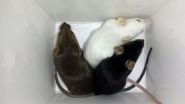(Press-News.org) Scientists have revealed the mechanisms that enable certain brain cells to persuade others to create 'Mexican waves' linked with cognitive function.
Ultimately, the team say their work may help researchers understand more about normal brain function and about neurocognitive disorders such as dementia.
Neurons are cells in the brain that communicate chemical and electrical information and they belong to one of two groups- inhibitory or excitatory. While much is known about excitatory neurons, the role of inhibitory neurons is still being debated.
Inhibitory neurons can vibrate and they are equipped with mechanisms that enable them to persuade networks of other neurons into imitating their vibrations - setting off 'Mexican waves' in the brain. The scientists believe these collective, oscillating vibrations play a key role in cognitive function. Their research sheds light on how inhibitory neurons use different communication processes to excitatory neurons, which share information via an internal pulsing mechanism.
This study was carried out by Imperial College London and the Max Planck Institute for Brain Research. It is published today in the journal Nature Communications.
Dr Claudia Clopath, co-author from the Department of Bioengineering at Imperial College London, said: "These brain cells are similar to spectators in a football stadium, encouraging others into imitating them in a Mexican wave. We suspect that there is a very close relationship between the collective vibrations that they set off and many important cognitive functions. When the vibrations are degraded so that the wave is disrupted, we think it may contribute to neurocognitive disorders such as dementia. Our hope is that ultimately our research will lead to new insights into these disorders and how they can be treated."
The researchers developed a mathematical model showing the two mechanisms that inhibitory neurons need in order to convince others to join them in their rhythmical vibrations. The first is the mechanism that enables the inhibitory neurons to vibrate on their own, known as sub threshold resonance.
The second mechanism is a nanoscopic hole known as a gap-junction. There are many of these on the surface of the inhibitory neuron and they allow neurons to communicate directly with one another, enabling inhibitory neurons to set off a collective vibration.
The fact that inhibitory neurons are able to determine how and when whole networks of neurons will vibrate suggests that they are much more important in brain function than scientists had previously thought, say the researchers.
Now that the team have described the mechanisms behind these vibrations, the next step will see them carrying out research on inhibitory neurons to fully understand why vibrations are important for cognitive functions. The team believe that there may ultimately be a way to manipulate inhibitory neurons to improve how they vibrate, which might one day lead to better treatments for people with neurocognitive diseases.
INFORMATION:
For further information please contact:
Monday:
Sam Wong
Research Media Officer
Imperial College London
Email: sam.wong@imperial.ac.uk
Tel: +44(0)20 7594 2198
After Monday:
Colin Smith
Senior Research Media Officer
Imperial College London
Tel: +44 (0)20 7594 6712
Email: cd.smith@imperial.ac.uk
Out of hours press officer mobile: +44 (0)7803 886248
"Oscillations emerging from noise-driven steady state in networks with electrical synapses and subthreshold resonance", published 18 November 2014 in Nature Communications journal.
Tatjana Tchumatchenko [1] , Claudia Clopath [2] [1] Department Theory of Neural Dynamics, Max Planck Institute for Brain Research, Max-von-Laue Str 4, 60438 Frankfurt am Main, Germany [2] Department of Bioengineering, Imperial College London, South Kensington Campus, London SW7 2AZ, UK
About Imperial College London
Imperial College London is one of the world's leading universities. The College's 14,000 students and 7,500 staff are expanding the frontiers of knowledge in science, medicine, engineering and business, and translating their discoveries into benefits for society.
Founded in 1907, Imperial builds on a distinguished past - having pioneered penicillin, holography and fibre optics - to shape the future. Imperial researchers work across disciplines to improve global health, tackle climate change, develop sustainable energy technology and address security challenges. This blend of academic excellence and its real-world application feeds into Imperial's exceptional learning environment, where students participate in research to push the limits of their degrees.
Imperial nurtures a dynamic enterprise culture, where collaborations with industrial, healthcare and international partners are the norm. In 2007, Imperial College London and Imperial College Healthcare NHS Trust formed the UK's first Academic Health Science Centre. This unique partnership aims to improve the quality of life of patients and populations by taking new discoveries and translating them into new therapies as quickly as possible.
Imperial has nine London campuses, including Imperial West: a new 25 acre research and innovation centre in White City, west London. At Imperial West, researchers, businesses and higher education partners will co-locate to create value from ideas on a global scale.
CHARLOTTESVILLE, VA (NOVEMBER 18, 2014). Neurosurgeons and neurointerventionalists at Kyungpook National University in the Republic of Korea have developed a formal protocol for delivering emergency treatment to patients with subarachnoid hemorrhage (SAH) from ruptured aneurysms within the first few hours after bleeding occurs. The emergency treatment plan, offered day and night, is shown to reduce the incidence of repeated hemorrhage during the hospital stay and improve clinical outcomes in patients with aneurysmal SAH. This treatment plan is described and discussed in ...
OAK BROOK, Ill. - Radiologists from the National Institutes of Health (NIH) and Emory University School of Medicine have issued a special report on radiology preparedness for handling cases of Ebola virus. The report, outlining their protocols and recommendations, is published in the online edition of the journal Radiology.
Healthcare administrators are placing a major emphasis on Ebola preparedness training at medical facilities throughout the U.S. Failure to have proper procedures in place to diagnose and treat patients with Ebola virus was cited as a major reason for ...
New federal regulations requiring school meals to contain more whole grains, less saturated fat and more fruits and vegetables, while perhaps improving some aspects of the food being served at schools across the United States, may also be perpetuating eating habits linked to obesity, diabetes and other diet-related diseases, an analysis by Johns Hopkins Bloomberg School of Public Health researchers has found.
The reasons: Based on analysis of school meals and the new requirements, the whole grains served are mostly processed, which means they are converted into sugar ...
NEW ORLEANS (Nov. 18, 2014) - Researchers from Drexel University in Philadelphia will present research on a wide range of public health topics emphasizing urban health challenges, geographic methods in public health, community resilience and more, at the 142nd annual meeting and exposition of the American Public Health Association Nov. 15-19.
A few selected highlights among the dozens of posters and presentations by faculty, staff and students from the Drexel University School of Public Health include:
What Makes Communities Resilient in Times of Adversity?
Psychologists ...
Early sodium supplementation for very premature infants can enhance weight gain according to a recent study by researchers at the University of Cincinnati Medical Center and Cincinnati Children's Hospital Medical Center.
The results of the study, published today in the OnlineFirst version of the Journal of Parenteral and Enteral Nutrition (JPEN), the research journal of the American Society for Parenteral and Enteral Nutrition (A.S.P.E.N.), examined 53 infants during the first months of life who had been born at less than 32 weeks of pregnancy.
Poor growth of premature ...
Researchers at Indiana University-Purdue University Indianapolis say acculturative stress may explain, in part, why Indiana's Latino youth face an alarming disparity in depression and suicide rates when compared to their white counterparts.
While examining epidemiological health disparities data, a team of researchers led by Silvia Bigatti at the Richard M. Fairbanks School of Public Health noticed that Latino teens in Indiana had a 65 percent higher rate of suicide attempts and a 24 percent higher rate of depression than white teens.
"When we saw the alarming disparity ...
Promoting and maintaining financial fraud whistleblower programs, such as those of the Securities and Exchange Commission (SEC) and the Commodity Futures Trading Commission (CFTC), is costly.
Cases involving whistleblowers require significant resources as they take nearly 10 months longer to complete. Rewards for whistleblowers who come forward with original information leading to an enforcement action can be large, ranging from 10% to 30% of monetary sanctions over $1 million. This past September, the SEC awarded $30 million to a whistleblower--it's largest award yet. ...
Researchers are studying the Caulobacter crescentus bacterium because of its developmental process and cellular cycle, which serve as models for a number of pathogenic bacteria. They all have in common the use of polysaccharides to create a particularly effective protective envelope, or capsule. Professor Viollier's laboratory at the University of Geneva's (UNIGE) Faculty of Medicine has just unraveled the secrets of capsule formation during the cellular cycle and perhaps even identified potential Achilles' heel of bacteria. These results were published in the last edition ...
SALT LAKE CITY, Nov. 18, 2014 - When a viral infection spread through five genetically identical mice in a row, the virus replicated faster and became more virulent or severe. But when the infection spread one-by-one through five genetically diverse mice, the virus had trouble adapting and became less virulent.
By showing this long-suspected mechanism holds true within a single species of vertebrate animal, namely, mice, the University of Utah study suggests that increased genetic diversity should be promoted in livestock and in captive-bred endangered species so as to ...
This news release is available in French. There is no significant difference in the prevalence of verbal abuse in the workplace between men and women, according to a systematic review of the literature conducted by researchers at the Institut universitaire de santé mentale de Montréal and the University of Montreal.
Verbal abuse is the most common form of workplace violence. It can lead to many consequences, particularly at the psychological and organizational levels. Several studies underline the importance of taking into account sociodemographic variables ...

